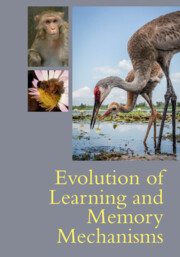Book contents
- Evolution of Learning and Memory Mechanisms
- Evolution of Learning and Memory Mechanisms
- Copyright page
- Contents
- Figures
- Tables
- Contributors
- Preface
- Introduction
- Part I Evolution of Learning Processes
- 1 Learning and Memory in the Nematode Caenorhabditis elegans
- 2 Adaptive Evolution of Learning and Memory in a Model Lineage
- 3 Learning in Insects: Perspectives and Possibilities
- 4 Experimental Evolution and Mechanisms for Prepared Learning
- 5 Evolutionary Processes Shaping Learning Ability in Insects
- 6 Brain and Spatial Cognition in Amphibians
- 7 Pavlovian Conditioning, Survival, and Reproductive Success
- 8 Compensatory Responses to Wildlife Control
- 9 Relational Memory Functions of the Hippocampal Pallium in Teleost Fish
- 10 Mechanisms Underlying Absolute and Relative Reward Value in Vertebrates
- 11 The Optimality of “Suboptimal” Choice
- 12 A Behavior Systems Framework
- 13 Dissociable Learning Processes
- 14 Social Learning Strategies
- 15 How Learning Affects Evolution
- Part II Evolution of Memory Processes
- Index
- References
11 - The Optimality of “Suboptimal” Choice
A Psycho-evolutionary Perspective
from Part I - Evolution of Learning Processes
Published online by Cambridge University Press: 26 May 2022
- Evolution of Learning and Memory Mechanisms
- Evolution of Learning and Memory Mechanisms
- Copyright page
- Contents
- Figures
- Tables
- Contributors
- Preface
- Introduction
- Part I Evolution of Learning Processes
- 1 Learning and Memory in the Nematode Caenorhabditis elegans
- 2 Adaptive Evolution of Learning and Memory in a Model Lineage
- 3 Learning in Insects: Perspectives and Possibilities
- 4 Experimental Evolution and Mechanisms for Prepared Learning
- 5 Evolutionary Processes Shaping Learning Ability in Insects
- 6 Brain and Spatial Cognition in Amphibians
- 7 Pavlovian Conditioning, Survival, and Reproductive Success
- 8 Compensatory Responses to Wildlife Control
- 9 Relational Memory Functions of the Hippocampal Pallium in Teleost Fish
- 10 Mechanisms Underlying Absolute and Relative Reward Value in Vertebrates
- 11 The Optimality of “Suboptimal” Choice
- 12 A Behavior Systems Framework
- 13 Dissociable Learning Processes
- 14 Social Learning Strategies
- 15 How Learning Affects Evolution
- Part II Evolution of Memory Processes
- Index
- References
Summary
Incentive salience denotes the biopsychological process that enables reward-related cues to be approached. Accordingly, organisms often prefer a cue predictive of a food reward delivered with certainty over one predictive of the same reward delivered with uncertainty. However, a closer examination of free-choice behavior in various experimental designs suggests that the principle of reward maximization is an oversimplification. In particular, many studies of suboptimal choice (SOC) reveal that organisms exposed to conditioned stimuli may prefer a food option associated with a lower total amount and a lower probability of food to the more profitable alternative option. In this chapter, I argue that SOC illustrates one important fact: reward maximization can be a correlate of choice behavior but it is not its cause. Instead, organisms track the cues that reliably predict food delivery, independent of the amounts received or the probability of being rewarded. I show how to understand this process in psychological terms and also why this view may make more sense than reward maximization from an evolutionary perspective.
- Type
- Chapter
- Information
- Evolution of Learning and Memory Mechanisms , pp. 193 - 209Publisher: Cambridge University PressPrint publication year: 2022
References
- 1
- Cited by



